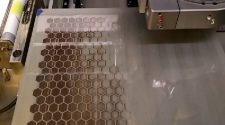Scientists estimate that nearly 60% of all cancer patients do not respond effectively to chemotherapy treatments. Even worse—many of those same patients experience toxic and sometimes deadly side effects.
Now, a Purdue University scientist and entrepreneur is working to use simple LED light to help determine if certain chemotherapy options will work for specific patients. The work is published in Scientific Reports.
“We are using a technique very similar to doppler radar used in weather to advance personalized medicine,” said David Nolte, the Edward M. Purcell Distinguished Professor of Physics and Astronomy in Purdue’s College of Science. “We take the LED light and shine it on biopsies. We then apply chemotherapy to the biopsies and analyze how the light scatters off the tissues.”
Nolte, who also is a member of the Purdue University Center for Cancer Research, said the light scattering dynamics give scientists and doctors detailed information about the likelihood of a chemotherapy drug being effective for a patient. Nolte said they have results within 24 hours. This first trial looked at biodynamic imaging on human patients with ovarian cancer.
“We look for signs of apoptosis, or what we call the controlled death of cells,” Nolte said. “Apoptosis is the signal that indicates the effectiveness of the chemotherapy for this patient’s tissues and tumors. For some cancers, there are so many treatment options available that it’s like a doctor is trying to fit square pegs in circular holes until a desired outcome is found. We want to make this process better for patients.”
Nolte has worked with several groups within the Purdue entrepreneurial and commercialization ecosystem, including the Purdue Foundry, on business plan development and management searches. AniDyn, a medical technology startup, was spun out of Purdue by professors Nolte and John J. Turek. AniDyn is focused on the development and commercialization of live-tissue imaging platform technologies.
New test could tell doctors whether patients will respond to chemotherapy
Zhe Li et al, Intracellular optical doppler phenotypes of chemosensitivity in human epithelial ovarian cancer, Scientific Reports (2020). DOI: 10.1038/s41598-020-74336-x
Citation:
Technology shines the light on ovarian cancer treatments (2020, October 22)
retrieved 22 October 2020
from https://medicalxpress.com/news/2020-10-technology-ovarian-cancer-treatments.html
This document is subject to copyright. Apart from any fair dealing for the purpose of private study or research, no
part may be reproduced without the written permission. The content is provided for information purposes only.

















